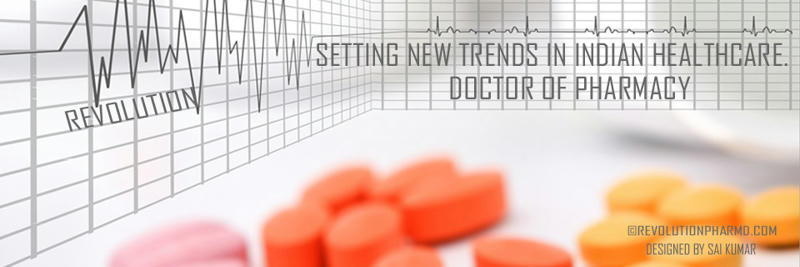Showing posts with label ARTICLES. Show all posts
Showing posts with label ARTICLES. Show all posts
Establishment, Development and popularization of Doctor of Pharmacy (Pharm d) Programme in India
This Article was sent to Revolution Pharm. D by Lin Mary George Second Year PHARM D students from National College Of Pharmacy(NCP), Manassery (P.O) Calicut, Kerala, India.
Abstract:
With the remarkable growth of hospitals,new challenges were
raised which necessitated more planing and co-ordination among the healthcare
professionals. There arised the concept of clinical pharmacy which in-turn lead
to the birth of pharm d programme. Initially the programme was introduced in
university of California in the year 1955.within a short while it attained wide
acceptance and popularity. The pharmacy education in India is not much old.
Though Madras medical college started pharmacy educational in 1860,it began as
a university programme only in 1932 at BHU(Banarus Hindu University). In 1999 a
remarkable attempt was made to start pharm d in India by Dr. Revikumar K.G in Trivandrum medical college, kerala. But
unfortunetly it failed. India and other countries came to think seriously about
pharm d when Foreign Pharmacy Graduation Equivalency Committee(FPGEC) in US
made it mandatory that a 5 year pharmacy graduation programme to be eligible to
appear for Foreign Pharmacy Graduation Equivalency examination(FPGEE).All these
prompted the authorities to introduce 6 year regular and 3 year post
baccalaureate Pharm d in the country during the year 2008.
A Guide for Foreign Pharmacists to Become Licensed in the United States
A foreign pharmacy graduate is a pharmacist whose
undergraduate pharmacy degree was conferred by a recognized school of pharmacy
outside of the 50 United States, the District of Columbia, and Puerto Rico.
This definition is regardless of whether you are a US citizen, permanent
resident (green card holder) or an illegal immigrant.
PharmD Students need to Develop Confidence and humility
During our PharmD training, we are expected to develop many
skills. We often find ourselves pushing the limits of our individual comfort
zones, attempting procedures and tasks that we have less than mastered. And to
deal with these potentially anxiety provoking situations, our pharmacy culture
teaches us to develop our self-confidence, and to do it quickly. In doing so,
we move beyond our insecurities, with the hope that those around us—our patients,
in particular—will feel assured in our capabilities. There is, however, a
danger in this pursuit.
Indian doctors need to promote prescribing drugs by their generic names
Do you ever compare prices of different brands of medicines before purchase ?
I would suggest that you do it - you will be surprised...!!!
Current Situation of Pharm.D in India.
1) It would be better if the Council makes the CROs and other Clinical/Drug safety related Industries to be aware of Pharm.D and the positions they will be eligible.
2) I have been trying to find an opportunity but some companies say – over qualification but some say – they r looking for MBBS or people with Experience.
3) Pharm.D in India itself is a new course and of course there will be no chance of Experience, then what a Pharm.D can do?
4) In the general public, there are several misunderstandings and even some people are getting confused too.
5) Final thing i would like to mention you is, there is no proper control on Pharma and its career, may be this condition is only for Indian Pharma graduates.
If possible please try to make these things notified by higher authority, WHO CAN BRING SOME CHANGE unless those who listens and says – lets wait, we have other works.
Thank you
Dr. Vijay Bhaskar Reddy K
Pharm.D
Pharm.D
GENESIS AND DEVELOPMENT OF PHARMACY EDUCATION AND PHARM D IN ASIA.
This Article was sent to Revolution Pharm.D by Second Year PHARM D (PB) students from Amrita School of Pharmacy,Kerala .
"
-
Message to DOCTOR OF PHARMACY STUDENTS
Society holds pharmacists
to a high degree of duty, integrity and honor, reflecting a responsibility to
their patients and their community. As developing professionals, it is the
responsibility of Pharm.D students to uphold these high expectations and to
conduct themselves accordingly by observing all applicable laws
as well as institutional policies, regulations and guidelines.
“PHARMACY THE CHALLENGE “-Roger Walker
in healthcare. As a consequence this puts the pharmacist at the heart of patient care and presents both opportunities and responsibilities.
Opportunities include direct patient contact and the
chance to understand the patient in the context of their own background, guide the
choice of therapeutic selection or formulation and provide appropriate,
personalized support to facilitate patient medication adherence.
But medicine use also has a down side. It has the
potential to be fraught with problems that include complexities of selecting the most
appropriate medicine,dose selection and administration, medicine formulation
and stability, the
potential to interact with other medicines, poor patient adherence and a changing harm-benefit risk profile.
As a consequence the mantra of promoting safe, appropriate
and cost-effective prescribing that respects patient choice and promotes
adherence is a continuous challenge. This is true whether we are students or
qualified pharmacists and requires a sustained enthusiasm to question and learn, and
a commitment to
continually update our knowledge and practice.
The emerging dimension that we also consider alongside the
patient focused approach is the public health perspective. No longer is it
acceptable to ignore the\ population based impact of any health care intervention whether this is linked to the inappropriate and wasteful use of healthcare resources
or involves overuse of
a given medicine. This is well illustrated by the
restrictions we must now place on the use of antibiotics to prevent the emergence of
antibiotic-resistance to preserve their effectiveness for use in those most in
need.
Whether we practice in a patient facing setting, work in
public health or combine the two dimensions, the opportunity for pharmacy to make a
significant and valued
contribution to healthcare and society has never been greater. This is our challenge.
Roger Walker
Chief Pharmaceutical Officer, Welsh Assembly
Government, U.K.
Subscribe to:
Comments (Atom)










